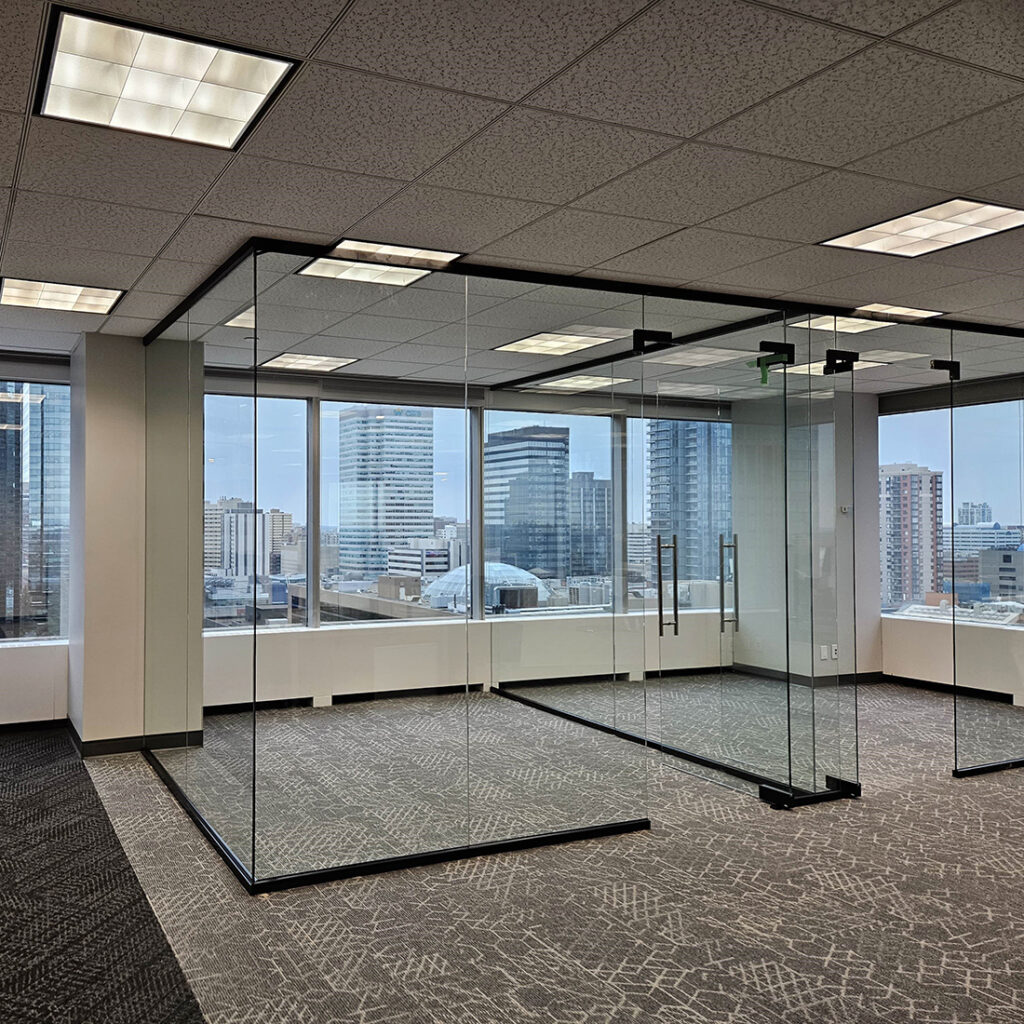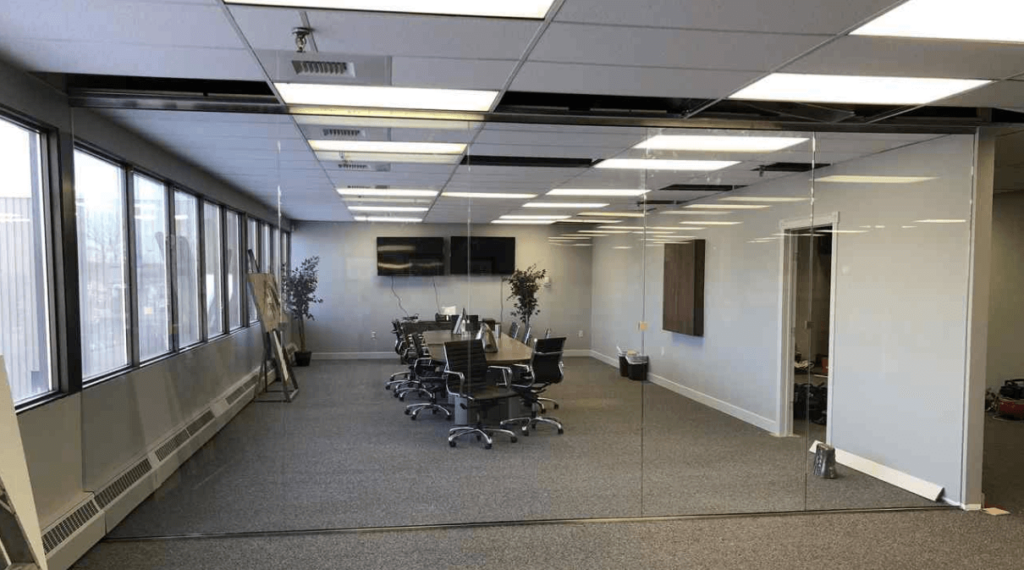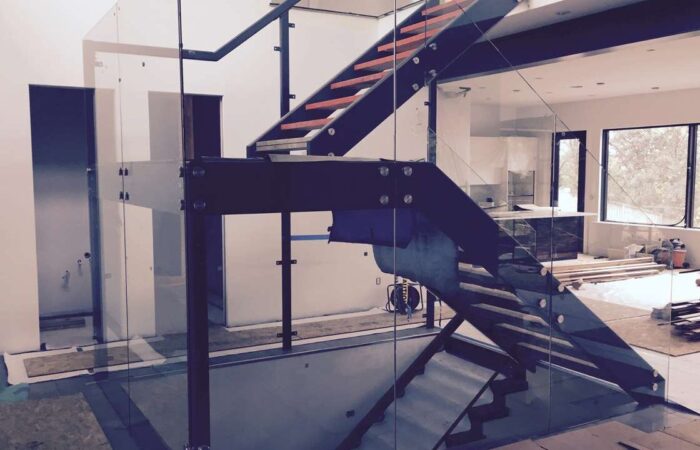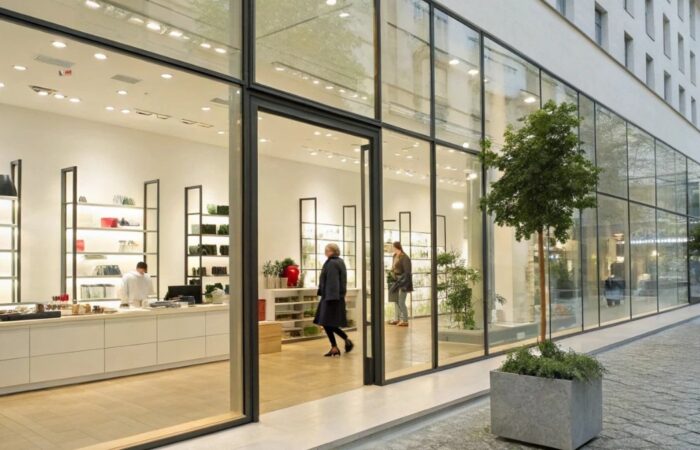
Glass Solutions for Commercial Spaces
In commercial design, aesthetics and functionality intertwine to create spaces that captivate visually and serve their intended purpose efficiently. It is within this intersection that innovative glass solutions have emerged as game-changers. When thoughtfully incorporated into commercial spaces, these cutting-edge glass technologies can completely transform environments, melding beauty with practicality and pushing the boundaries of what is possible in design. This is a deep dive into the world of innovative glass solutions for commercial spaces and how they can revolutionize aesthetics and function.
The Impact of Glass in Commercial Design
Aesthetic Appeal: Transparency, Light Flow, and Modern Look
One of the most distinctive aspects of incorporating glass in commercial spaces is its undeniable aesthetic appeal. The transparency of glass contributes to a sense of open space, fostering an atmosphere of vibrant, unfettered energy. This openness also allows for optimal light flow, turning commercial spaces into well-lit areas that evoke a sense of warmth and welcome. With its sleek, seamless look, Glass blends effortlessly with various design styles, lending a touch of modern sophistication that elevates the overall visual appeal.
Functional Benefits
Durability
Glass solutions for commercial spaces offers more than just aesthetics. Its intrinsic durability ensures a long lifespan, capable of withstanding the high traffic and usage that commercial spaces often entail.
Easy Maintenance
One significant advantage of glass is its easy maintenance. Glass surfaces typically require only simple cleaning for upkeep, making it a convenient choice for commercial spaces.
Customization Options
Innovative glass technologies provide extensive customization options. From varying levels of transparency to a wide range of colours, textures, and finishes, commercial spaces can be tailored to meet specific design requirements. Glass’s versatility and value make it an excellent material for commercial design.
Customization and Personalization in Glass Design
The Role of Customization in Commercial Projects
Customization is a critical facet of glass design in commercial settings, birthed from the growing demand for originality and distinction in architectural spaces. The capacity to tailor glass properties such as colour, transparency, and texture means that each piece uniquely expresses the corporation’s identity and vision. This level of customization allows for the creating of distinctive, memorable environments that resonate with those who interact with the space. Moreover, tailor-made glass solutions enhance the functionality of commercial spaces, ensuring that they meet specific operational requirements and adhere to safety standards. This fusion of form and function positions glass at the forefront of commercial design innovation.
Examples of Personalized Glass Designs
Personalized glass designs have taken creative expression to new heights in commercial design.
Techniques such as etching allow for intricate designs to be permanently marked on the glass surface, adding an element of visual intrigue. This method can incorporate corporate logos, patterns, or any design element that complements the space’s aesthetic narrative.
Tinting offers another layer of customization, lending a splash of colour to the glass and altering the space’s ambience. The colour intensity can be adjusted to achieve the desired level of privacy and light transmission.
Lastly, shaping presents endless possibilities for personalizing glass design. From gently curved glass walls to dramatically angled facades, shaping allows designers to push the boundaries of what is possible with glass in commercial spaces.
These examples underscore the remarkable versatility of glass as a medium for personalized design in commercial settings.
Technical Aspects of Commercial Glass
Safety Standards, Thickness, and Load-Bearing Capacity
When incorporating glass into commercial design, it is imperative to consider several technical elements to ensure the safety and durability of the space. Safety standards are critical, with regulations in place to protect users from hazards associated with glass use. These standards define the minimum requirements for glass strength, durability, and impact resistance. Thickness is another vital consideration. Thicker glass provides greater strength and better sound insulation, increasing cost and weight. Therefore, choosing the right thickness is crucial based on the project’s requirements and budget. Lastly, load-bearing capacity determines the maximum weight a glass element can support without breaking. This is especially important for structural glass elements such as floors and stairs, where the load-bearing capacity must be sufficient to handle the expected human traffic and weight.
Innovations in Glass Technology for Commercial Projects
Innovations in glass technology have unleashed a plethora of possibilities for commercial design. Smart glass technology, for instance, allows the transparency of glass to be altered at the flick of a switch. This provides incredible control over privacy and light transmission, creating dynamic spaces that can adapt to different needs. Insulated glass units (IGUs), also known as double glazing, have transformed the energy efficiency of commercial buildings. With two or more glass panes separated by a gas-filled space, IGUs significantly reduce heat transfer, resulting in lower energy bills and a more comfortable indoor environment. Furthermore, structural glass technology has created impressive and complex glass structures. This type of glass is designed to bear loads and resist weather conditions, opening up exciting design opportunities for commercial spaces. These innovations represent just a fraction of the immense potential that glass technology holds for the future of commercial design.
Enhancing Retail Spaces with Glass Features
How Glass Can Improve Retail Environments
- Shopfronts:
Transparent glass shopfronts create an inviting atmosphere, allowing passersby to glimpse the products inside, thus attracting potential customers.
- Display Cases:
High-quality glass in display cases guarantees clear visibility and showcases the products beautifully while also providing a protective barrier.
- Interior Partitions:
Glass partitions effectively divide space within the store without impeding light or visibility. This means even in a partitioned space, products can be easily seen, promoting a sense of openness and ensuring the entire product range is accessible to the customer’s eye.
The Role of Glass in Creating Inviting and Visually Appealing Retail Spaces
Glass plays an integral role in creating inviting and visually appealing retail spaces. Its transparency enhances natural lighting, creating a bright, welcoming environment that can improve customer mood and boost sales. In contemporary retail design, glass is often used to create striking visual effects. For example, coloured or textured glass can add interest and differentiate a retail space. Smart glass can also be utilized to dynamically control the level of privacy in certain areas of the store. Ultimately, the aesthetic versatility of glass, coupled with its practical advantages, makes it an invaluable tool in creating attractive, customer-friendly retail environments.

Enhancing Commercial Office Spaces with Glass Features
How Glass Can Benefit Office Spaces
- Open-Plan Offices:
Utilizing glass partitions in open-plan offices can maintain the perception of openness while also providing designated workspaces. This helps to minimize noise and potential distractions without making employees feel isolated.
- Meeting Rooms:
Glass walls for meeting rooms allow natural light to penetrate further into the office, creating a more comfortable and productive work environment. Smart glass can be used for added privacy during meetings or presentations.
- Exterior Windows:
Large, high-quality glass windows can provide breathtaking views, reducing the feeling of confinement often associated with office environments. Furthermore, they allow natural light to flood the workspace, improving employee mood and productivity.
The Role of Glass in Creating Efficient and Attractive Office Spaces
Glass plays a critical role in modern office design, fostering a sense of transparency and openness. It can enhance natural lighting, reduce the need for artificial lighting, and contribute to energy efficiency. Glass partitions and doors can also create an impression of space, making the office appear larger and more spacious. Moreover, glass can be customized to suit specific design aesthetics—through tinted glass for a more private area or frosted glass for a touch of elegance. Therefore, glass is a practical material for office spaces and a powerful design element that can shape the office’s overall look and atmosphere.
Maintenance and Durability
Long-term Benefits of Using High-Quality Glass in Commercial Spaces
High-quality glass in commercial spaces is an investment in aesthetics, durability, and longevity. This type of glass is often manufactured to resist scratches, cracks, and other damage that can compromise its clarity and overall appearance, thereby maintaining the design integrity of the commercial space over time. High-quality glass also offers enhanced energy efficiency, reducing heating and cooling costs and thus providing significant long-term cost savings. Moreover, high-quality glass tends to be more versatile, with the ability to be customized to meet specific design or functional requirements without sacrificing durability. This ensures that the glass maintains its original properties, such as colour, transparency, and texture, even under constant use or exposure to environmental factors.
Tips for Maintenance and Cleaning to Preserve Aesthetics and Durability
Regular maintenance and proper cleaning are key to preserving the aesthetics and durability of glass in commercial settings. Use a soft cloth or sponge and a mild, non-abrasive cleaner to wipe the glass surface gently. Avoid harsh chemicals or abrasive tools, which can scratch the glass and diminish its transparency and shine. For stubborn stains or marks, professional cleaning services may be warranted. In terms of maintenance, regular inspections should be conducted to identify potential issues, such as cracks or chips, which should be addressed promptly to prevent further damage. Additionally, any moving components related to glass elements, such as door hinges or window sliders, should be kept well-lubricated to ensure smooth operation and prevent undue stress on the glass. With appropriate maintenance and cleaning, the aesthetic appeal and durability of glass in commercial spaces can be preserved for many years.
Future Trends and Potential Innovations in Commercial Glass
Future Trends and Upcoming Innovations in Commercial Glass Design
The commercial glass design and application world is poised for exciting advancements in the coming years. One anticipated trend is the integration of technology into glass elements. We expect to see more ‘intelligent’ glass that changes its properties based on external stimuli, altering its opacity or generating energy. Another anticipated trend is the increased use of 3D printing technology for glass manufacturing. This would offer unprecedented design flexibility, enabling complex shapes and structures that are currently challenging to achieve. Material advancements that improve glass’s strength, flexibility, and lightness are also on the horizon. This could open up new applications for glass in commercial spaces, including as load-bearing structures and for enhanced sound insulation.
Potential Advancements in Sustainability, Smart Technologies, and Aesthetic Designs
The pursuit of sustainability continues to be a driving force in the commercial glass industry. Future advancements may include the development of glass that can harness solar energy more efficiently, thus reducing the reliance on conventional energy resources. In terms of smart technologies, we could witness the proliferation of interactive glass surfaces that offer touch sensitivity, opening up the potential for interactive displays and augmented reality applications. This could radically transform the way commercial spaces are experienced and utilized. Furthermore, aesthetic design methods are set to evolve with advancements in digital fabrication, enabling more intricate and personalized designs. New treatments and finishes could also expand the palette of colours, textures, and light effects achieved with glass. As these trends and innovations unfold, the role of glass in commercial design is set to become even more influential and dynamic.
Conclusion
In conclusion, innovative glass solutions for commercial spaces present enumerable benefits, serving as a functional, aesthetic, and sustainable choice. The versatility of glass allows it to enhance the appeal, comfort, and functionality of commercial environments, from retail stores to office buildings. Glass shopfronts, display cases, and interior partitions foster an inviting, transparent, and well-lit ambience, while future innovations promise smart, interactive, and energy-efficient applications.
Red Seal Glass, located in Edmonton, Alberta, is unwavering in our commitment to delivering high-quality glass solutions. We are experts in glass applications for residential and commercial projects. With over 30 years of experience and a deep commitment to the glazier profession, we guarantee the highest quality workmanship and reliability. We take pride in sourcing all our products locally and are dedicated to supporting the Alberta economy. Contact us through our website’s contact form today and tell us about your project!

